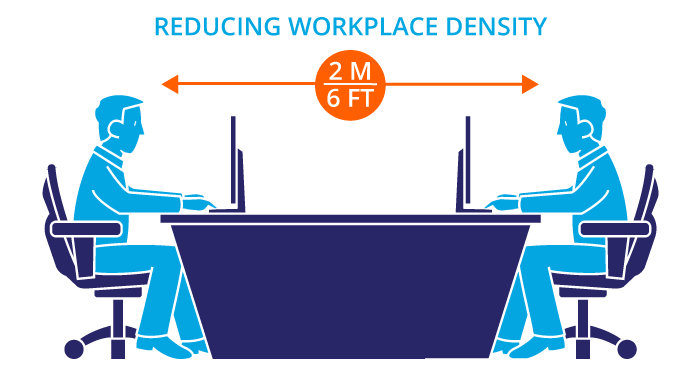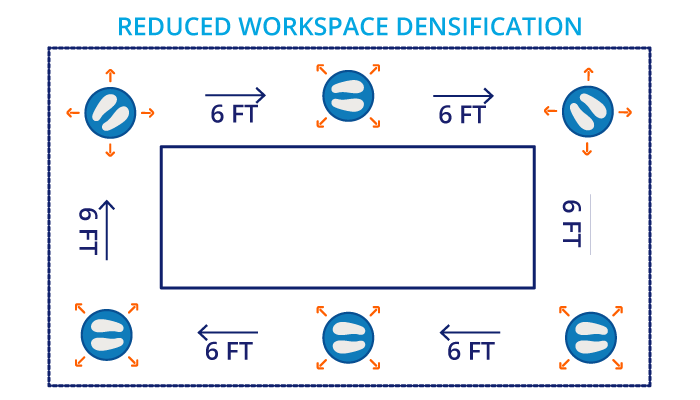Changing Workplaces – Thoughts on Post-Pandemic Workspaces
We share a few thoughts on workplaces becoming non-tactile and managing environments in the post-pandemic period, and invite you to comment and share your insights.
Assessing the scope
There are two main areas of concern in workplaces: tactile surfaces and managing the air in the work environment. Both are directly related to containing the spread of viral infections through engineering controls. Behaviour modifications will be primarily outside of the scope of this article except concerning how they can be manipulated by means of building and environmental design changes.
There are broad implications when addressing these two areas. We will only touch on some of them superficially. Our goal here isn’t to provide answers. Instead, we first seek to provoke thoughtful consideration and secondly a reasoned discussion of possibilities.
Employee density
As employers are permitted to allow workers to return to office, retail and other commercial workplaces, the issue of maintaining physical distancing must be addressed. Some will not return for a myriad of reasons, including elevated risk factors for themselves or dependents, personal anxiety, loss of employment or the ability to work from home with ease and efficiency. These factors will serve to reduce employee density.
However, this does not automatically make workplaces suitable for returning employees to maintain physical distancing. Many shared workspaces were designed to maximize density, and these spaces will still be unsuitable for returning employees. It is estimated those office environments will lose 50% of their previous capacity. Workstations that are less than two metres apart, or those that face each other may only allow for every other workstation to be occupied diagonally to those across from them.

High-density workplaces also increase the demand placed on cleaning crews. Daily cleaning of elevators may still leave hundreds of people exposed to contaminated surfaces. The same for cafeterias and washrooms, meeting rooms and doors. Elevators, designed to hold many people in close proximity, will now have reduced capacity to one or two persons.
The increased use of aerosol disinfectants will inevitably give rise to respiratory irritation with increased exposure to harsh chemicals. Reducing the risk of contact contamination will have other side effects on human health.
Transit
Social distancing and work from home (WFH) have reduced public transit ridership to a mere fraction of its former use. It is difficult to see how social distancing and surface disinfection can be maintained on busses and trains. There are so many surfaces and hand-holds that are required for safety while standing or moving on these vehicles.
Will the risks of infection on public transit drive people back to personal vehicles? What impacts will this have on traffic congestion and parking in our cities? Will we see increased environmental impacts if more people choose to return to work using cars?
City planning
City designs may change to having wider sidewalks and pedestrian pathways to facilitate separation between people. This, of course, is much easier to write into building codes and city planning policies than it is to retrofit in existing infrastructure. There may not be enough space to accommodate both roads and wider walkways. One proposal is to reduce roadways in favour of broader pedestrian pathways while at the same time changing zoning regulations to permit a much greater range of mixed uses. The idea is to create mini-communities of residential, retail and office, and supply all within walking distance.
The concept of small communities where all necessary amenities are within walking distance is not at all new. In fact, before the invention of the personal automobile, that was the norm for all communities. It will be interesting to see a return to the old ways of city community design combined with online shopping providing worldwide access to goods. This concept could provide many benefits, including shopping local, reduced commuting and related environmental effects, a physically healthier population and a greater sense of community. All the while, helping reduce the spread of infectious diseases.
Reducing tactile surfaces
Workplaces contain an amazing number of tactile surfaces: light switches, keyboards, coffee and vending machines and serving utensils. Nearly every piece of office equipment has a button keypad. Handles are on everything: washrooms, closets, cupboards, entrances, drawers and cabinets. Humans use their hands for everything!
Sensor technology has enabled us to reduce the number of tactile surfaces we need to touch. Occupancy sensors have replaced light switches while simultaneously reducing energy consumption, and motion sensors have replaced faucet handles in washrooms. Fobs can replace keys and keypads for access systems. New technology is demonstrating that contactless holographic projections can be used instead of metal elevator buttons. While these systems can be expensive, the engineering difficulty is quite low for the implementation.

We will likely see a redesign of office equipment used by more than one person that further reduces the need for contact. Buttons on multifunction office printers/scanners/copiers may be removed and replaced by touchless technology or alternative processes. This may finally drive paper use down to near zero in offices, something that was predicted long ago that hasn’t happened yet.
Building design
Building codes invariably get more complex and all-encompassing over time. Over the last decade, the primary driving forces of change have been the reduction of building energy usage and internal environment conditions. Expect to see numerous changes to building design requirements and allowable capacities as a result of the knowledge gained during this pandemic.
Designing buildings for less touching and wider separation is possible. Many large facilities, such as stadiums and airports, have washrooms without doors by using winding entrances. For large buildings, the space penalty isn’t significant. However, the predominantly smaller workplaces simply do not have the space to rework the interior to meet those designs. It will be economically infeasible to reconfigure and rebuild many older compact layouts to meet the new standards. Add to that the reduced permissible occupant load and the market rents and value of older buildings will decline significantly. Low-valued buildings in good locations will lead to an increase in redevelopment. Combine these opportunities with changes in city planning bylaws and policies, and we could see significant progress towards the small community proposal outlined earlier.
Internal air quality will likely become a focal point. Already we see an increase in interest in HVAC disinfection systems through UV lights and better filtration media. With the increased use of aerosol disinfectants and airborne viruses, the number of air changes per hour will also be increased to improve the indoor air quality.
Internal traffic patterns
Traffic patterns within buildings have already been altered to prevent people from passing close or bunching up. This is accomplished through the use of arrows and spacing indicators in lines and waiting areas. Expect to see wider hallways or even unidirectional hallways and traffic patterns designed into new buildings. Mats with circles indicating personal space areas are already available and are showing up in office opening plans across Europe and North America. With separated workspace fixtures becoming firmly in favour, the purchase price of densifying office furniture is now steeply discounted. The pandemic regulations have reversed a decade long trend of workplace densification in mere months.

What are your thoughts?
These are just some of the current thoughts on the changing workplaces in the near future. Doubtlessly politics, legislation, engineering, economics and human behaviour will play important parts in the developing story over the coming months and even years. While disruptive, the circumstances also provide the opportunity to innovate and improve. Let’s choose to be positive and use the forces that have been unleashed to make the world, our world, a better place for all. We invite you to add to these topics. What things did we miss? Are there other solutions that can address multiple facets simultaneously? Share your insights and join the discussion.
Disclaimer
This article is for informational purposes only and is not intended as professional advice; please consult a competent professional for advice specific to you. This blog is written to stimulate thinking on concepts related to commercial leasing. Please join the discussion with your experiences.

Martin Sommer, CEO, CRESS Inc.
Martin is a founder and the CEO of CRESS Inc., a Canadian SaaS company that automates lease administration and asset management. Martin also manages Karanda Properties Limited industrial portfolio as Director of Operations in all areas of commercial property management, including new development, asset management, capital expenditures, operations, leasing and lease administration of the industrial portfolio. Martin writes about property management workflow and issues. Book Martin to speak at your industry event.













